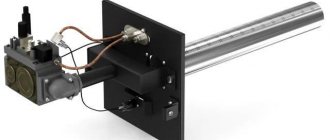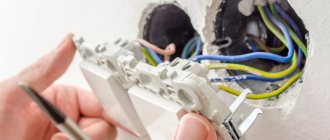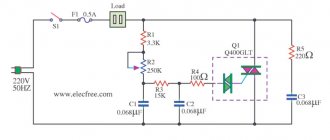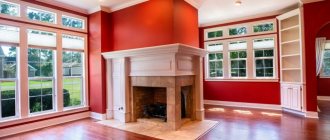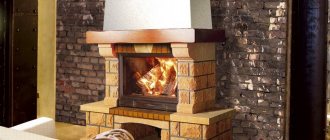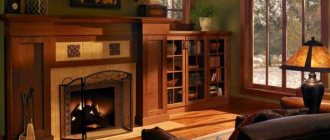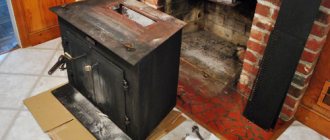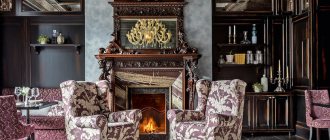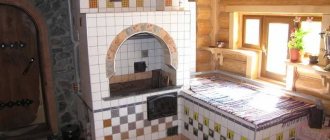Before considering all the issues related to combining two independent devices into one, you need to understand the difference between a stove and a fireplace, because they cannot always be recognized only by appearance. In operation, the stove and fireplace use fuel combustion, heating the room acts as the main function, but the fireplace must heat only the room where it is located, and it must do this quickly and efficiently. The stove must bring heat into all rooms of the house and retain it for some time even after complete combustion of the fuel.
The main tasks are realized by the structural features. In rooms that do not have large areas, it is not possible to install one and another device at the same time, and no one wants to give up high-quality heating or a cozy fireplace. Especially for such cases, ready-made projects have been developed in which the stove and fireplace are combined in one device.
Original island plan design
Merging options
There are several approaches to solving the problem of combining two structures. Their type depends on the stage at which such a decision was made. The most popular are two ways to accomplish the task.
- Installation of two fireboxes in one housing. As a rule, already at the stage of pouring the foundation it becomes known that the future structure will perform two types of tasks. The body of the fireplace is laid out according to a certain pattern, in which two fireboxes are formed. One firebox belongs to the stove, and the second to the fireplace. Common models are those that are a stove on one side and a fireplace on the other. These devices heat different rooms, and it seems that they function separately.
- Equipping the furnace firebox with a glass door. This allows you to turn a stove into a fireplace with a minimal investment of money, preserving all the functional features of the original device. Thus, a fireplace stove is obtained thanks to an elementary addition.
In general, combining a stove and fireplace made of brick is not so difficult. But the stumbling block is always the chimney. The fact is that, according to calculations, the areas of the smoke channels do not coincide. Metal structures successfully cope with this problem by installing an average option. Brick models often require the installation of two separate chimneys.
Ready-made fireplace and stove complex
Undoubtedly, if two devices are combined into one, then there are only one advantages, however, in the case when the originally built stove was built by your predecessors and you want to make two functional devices out of it, you will have to call a professional craftsman. Even if you plan to carry out all the work yourself, you need a clearly developed plan. It will tell you exactly how to implement the join.
Good to know: Heating and cooking brick stoves and their use in homes
What you need to purchase to build a stove
First you need to purchase masonry mortar and bricks. The amount of material will be calculated by a specialist. Do not forget about constructing a separate foundation for installing the furnace. The equipment will require cast iron elements: a door for the firebox, a blower (ash pan door), rings for the burner, a chimney valve, a grate and a hob.
In addition, it is necessary to purchase steel elements: a hot water tank and an oven. When building a structure, you will need strips made of metal of different widths and lengths. A corner made of metal of standard size 0.5 x 0.5 cm. Annealed steel wire with a diameter of 0.2 - 0.3 cm. A sheet of steel must be placed before the firebox.
Some designs may require roofing iron to cover the cooking chamber.
The required amount of material is calculated by a specialist based on the size and type of oven.
Long-burning wood-burning brick stoves for homes are built from fireclay and red bricks, clay and sand. To build the foundation you will need sand and cement, crushed stone, roofing felt, as well as boards for formwork.
Doors and gratings (grids) are mounted along the masonry of the main structure Source extracraft.ru
Work in two modes
A stove combined with a fireplace can be operated in two modes. These modes differ in purpose and performance.
- In fireplace mode, the focus is on visualizing the combustion process itself. It is necessary to provide the opportunity to observe the flame from anywhere in the room; do not forget that this is one of the functions of the fireplace.
- As for heat generation, it should be presented in the form of directed radiation. Such energy can quickly warm up a resident located nearby.
To be able to switch to fireplace mode, you need to ensure the construction of a vertical, straight fireplace chimney. In this case, a huge portion of the heat will escape along with the smoke, but this design supports intense combustion, during which infrared heat is emitted.
Large brick building
The oven mode must use heat efficiently. For these purposes, some technological features of the structure of the firebox, smoke collector, and chimney are provided. Remember the appearance of the Russian stove; it takes up a good amount of space in the house, despite its relatively small size of the firebox. A channel is installed in the stove body through which smoke and warm air enter the chimney. As it moves through the channel, the air gives off some of its heat to the brickwork.
If a stove combined with a fireplace has two different fireboxes, then issues of switching from one mode to another should not arise, but combining it into one device with a common firebox requires introducing some operating rules. To switch between modes, you need to ensure that the flow of combustion products is redirected into one or the other chimney. This is done using a conventional damper.
Useful tips for laying a brick stove for a summer cottage
- Always monitor the thickness of the seam while laying bricks. It should be 5 mm.
- Check the first row not only with a building level, but also diagonally.
Checking the diagonal of row 1
- Start placing each new row on the previous row only when you check it horizontally with a building level and vertically with a plumb line. To ensure even angles, use a protractor all the time. Then it will be difficult to correct your mistakes.
- When laying a cast iron hob on a brick, it is necessary to lay a layer of clay mortar on it. This will protect the brick from heating.
- To ensure good draft and prevent the formation of condensation, you need to make a short gas exit path. The so-called summer run. Through this path, gases enter the chimney. After the stove lights up well, close the damper.
- Start each row from a corner.
- When laying out each new row, make sure that the new brick overlaps the joint of the previous brick.
- The size of the chimney and chimney must be the same diameter.
At the end of the article, we recommend that you read the instructions for laying a wood-burning stove for a summer house.
The video describes in detail the process of laying a simple brick kiln on a dry
Main types
In words it is quite simple to explain the principle of unification according to which the fireplace stove is built. The real device is complicated by the fact that today it is customary to equip it with additional functions. Thus, there are models with ovens, hobs, niches for drying fruit, barbecues, barbecues, etc.
- Ancient traditions are embodied in modern stoves with benches. Of course, the stove has somewhat lost its purpose, and the stove bench serves, for the most part, to add some color, but it is functional. You can climb on it at any time and warm up. Such stove options require a dedicated area of the room. So think about where you can install it.
- Due to its shape, a wall-mounted wood-burning stove-fireplace does not take up very much space, but it allows you to heat two adjacent rooms at once. It is mounted so that its firebox opens into one room, and the back wall is part of the partition. In a small house, this design will provide warmth in any weather.
- A real center that can gather everyone around it is a stove with an oven and a hob. It can zone a room, allocating space for a full kitchen and a hallway. To welcome guests and prepare a festive dinner, it is enough to light only one firebox. As a result, you can get a warm room, a great view of the burning flame and a lot of cooking possibilities.
Home while working
Safe Operation
A double-sided fireplace is an interesting design, but when using it you need to take into account some points in order to only enjoy its presence in the house and not have unpleasant problems:
- The first rule that must be followed is not to leave the fireplace unattended while it is burning.
- Do not open both doors at the same time to avoid burning wood or sparks falling onto the floor surface. In addition, a draft can create a reverse draft, and smoke from the firebox can enter the room, and this is an unpleasant odor that is quickly absorbed into furniture and clothing.
- Another important step is to decorate the fireplace area with non-combustible material, for example, ceramic tiles, and this must be done on both sides of the firebox.
- To avoid excessive smoke in the firebox and get high-quality heat, you need to use fairly dry firewood.
Pros and cons of combined devices
A brief summary of the theory described above will be the highlighted advantages and disadvantages of fireplace stoves. Among the advantages it should be noted:
- Combining a stove and fireplace into a single device saves space without losing the basic functional qualities of each of them.
- The ability to switch between modes allows you to use the design for a short stay in the house or as a real heating system.
- The fairly large power of the furnace will ensure heating of the coolant, which means that such a system can be equipped with a water circuit.
- Additional options in the form of a hob, barbecue or oven emphasize the versatility of the stove.
- The radiation of the fireplace and the heat transfer of the stove, when combined, increase efficiency by up to 80%. Using a fireplace stove, you can fill several rooms with warm air at once.
Good to know: Electric oven for making pizza at home
The disadvantages of such devices are rarely discussed, but they exist:
Firebox design for a multifunctional brick structure
In the first place is the huge mass of the furnace.
- It will not be possible to build a fireplace stove in a hurry, since any arrangement is a rather complex scheme.
- Complexity in structure determines complexity in maintenance. Often it is necessary to clean the channels, for which it is necessary to partially disassemble the labyrinth of the furnace, and this is a rather labor-intensive task.
Selecting the size of the finished double-sided firebox
The easiest way, of course, is to purchase a ready-made double-sided fireplace insert in a store; it will look good both in appearance and in functionality it will please the owner. Beautiful welding seams, spectacular painting and other decorative little details of factory fireboxes clearly distinguish them from homemade ones. Look at this photo:
Ready-made factory firebox for a two-sided fireplace
Manufacturers, knowing the different tastes of consumers, try to satisfy all needs. Therefore, if you buy a cast iron firebox, you can find exactly the option that is more suitable for the fireplace itself and for the interior in which it will be located.
- Cast iron fireboxes are available in different sizes, and they are used in different fireplaces, as well as as an independent stove, equipped with a stand. For example, as done in the presented photo.
You can do it in the simplest way
- Fireboxes have different shapes, from classic rectangular and square to semicircular and asymmetrical.
- The walls of the firebox are reliable, as they are finished with fireclay material or have a heat-resistant layer between two metal sheets.
- Fireclay tiles made to resemble stone or brick are well suited for wood-burning brick fireplaces. They will go perfectly with the exterior decoration of the portal.
- Cast iron fireboxes usually have a horizontal arrangement, but some models are also made in a vertical version.
- Fireboxes, as a rule, have two hermetically sealed doors made of heat-resistant glass, which will allow you to admire the flames from both sides. This glass is designed to withstand high temperatures, reaching up to 700-750 degrees.
There are also more original door options - they can rise up or slide to the side.
Basically, the glass installed in the doors has a straight, even shape, but in some models trapezoidal and semicircular glass is used.
It must also be said that some models of fireboxes are equipped with automated doors, one of which is blocked when lighting a fire in the fireplace, in order to avoid drafts and fire.
If you want to admire a live fire in an open firebox, one of the doors can be open, but the second one must be closed.
If a bio-fireplace is installed, then the firebox for it is usually included. An electric fireplace that has the effect of a living fire also has a ready-made firebox, for which you only need to create a suitable portal.
Basic requirements for combined models
There are often concerns about the safety requirements for combined fireplaces and stoves. All points, including the correct choice of location, are considered relevant.
It is necessary to plan the installation of a fireplace stove as early as possible. It's not just that you'll have to dismantle the floor to build the foundation. Just the presence of such a massive unit in a room cannot but affect its layout. Therefore, assume in advance that there are no wooden walls or flammable materials nearby. If it is not possible to exclude a dangerous neighborhood, then the entire coating should be provided with fire-resistant insulation.
Proper start-up of a new furnace is considered the key to its reliability. Fulfill all requirements for drying a newly built structure. Other issues related to the safety and compliance of the product are provided for in the finished designs of fireplace stoves.
Where is the best place to install a fireplace?
There are several options for installing a tunnel fireplace.
In the photo: electric tunnel fireplaces of various locations
The fireplace is installed in the center of the room and is intended not only for interior decoration, but also for zoning. Often in this way they divide the dining and kitchen areas, or the living and dining rooms. This allows you to visually reduce the room and use it as two separate rooms.
Pictured: electric tunnel fireplaces in the center
The fireplace can be placed in a wall niche. In this case, the fireplace will become part of the main wall separating the two rooms. Visually it will look like two completely different fireplaces in two rooms.
In the photo: electric tunnel fireplaces in a wall niche
Hanging fireplace. This non-standard solution will become a real highlight of any interior. The fireplace is attached to the ceiling and is located anywhere in the room. It seems to float in the air without touching the floor. Of course, the design of such a fireplace should be initially intended for such an installation, since its weight should be significantly less than the weight of a standard fireplace.
In the photo: hanging tunnel wood-burning fireplaces
Installation in the center of the room. A fireplace of any shape and size can be installed in the center of the room. It doesn't share space.
Pictured: electric tunnel fireplaces in the center of the room
Wall-mounted fireplace. One side of the fireplace can be installed next to the wall, which, again, will allow you to visually divide the space, but not the whole room, but a small area, for example, to separate a work desk and a sleeping place from each other.
Finishing
In absolutely all cases, the resulting fireplace will have to be decorated from the outside. It can simply be coated with a layer of glossy or matte paint. Here you need to remember the elementary laws from the physics course. Dark bodies emit more energy, and since our task is to remove energy, black colors will be a priority.
Good to know: Wood-burning fireplaces for the home, the main advantages of using such devices
The fireplace can be finished with special fireproof materials. These include tiles made of ceramics, artificial and natural stone. When gluing tiles, you should remember the thermal expansion of the metal, so the seam gap should be slightly increased.
With the possibility of making your own fireplace, a lot of opportunities open up for you to realize your old dream exactly in the form in which it interprets itself. Desire and work in a certain sequence will ensure an excellent result.
Chimney from a pipe
Having made a metal fireplace with your own hands, you can proceed to an equally important stage - preparing the chimney. It does not require welding work. It is recommended to use ready-made steel pipe.
Exiting the pipe to the roof
The pipes are joined using the provided socket. This is a special extension that allows you to insert one end of the pipe into the other. If there is no such socket, then the edge of the pipe should be cut with metal scissors, and the junction of the pipes should be treated with heat-resistant sealant.
A direct-flow duct is not a mandatory requirement for a chimney for metal fireplaces. Various elbows can be used to direct the smoke along the desired path.
When passing through ceilings, you will definitely have to take care of safety by insulating the chimney. Asbestos material or mineral wool are suitable for this. This procedure is also expected when the pipe exits the roof.
Real live fire
The top of the pipe is covered with a canopy. It will prevent precipitation from getting inside the pipe and will protect against excess debris, and will also prevent sparks from flying out.

